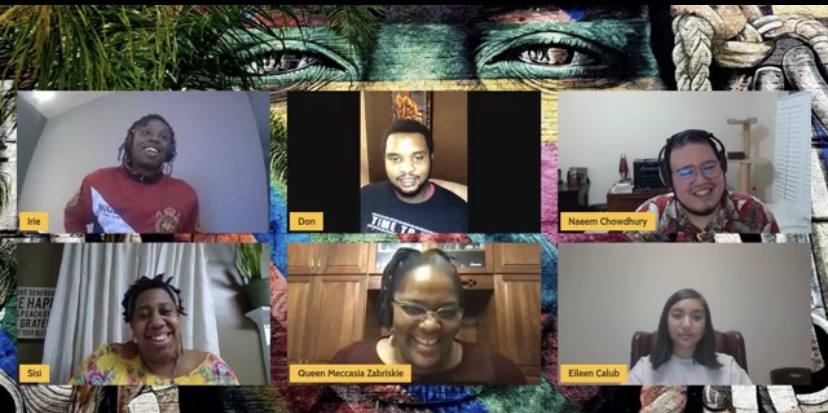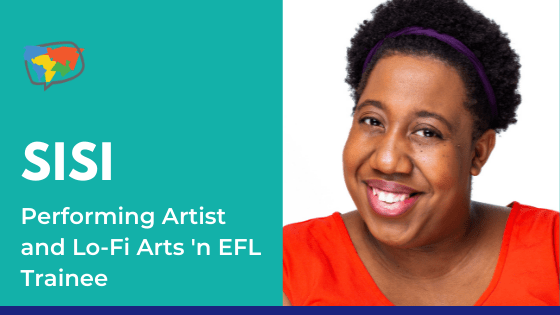Sharing art knows no bounds for artist and Bridge student Sisi Reid as she takes creativity to a new stage: the English classroom. Fueled by her love of art and teaching, she’s currently training under the Lo-Fi Language Learning’s Arts ‘n EFL program, which aims to help English teachers integrate hip-hop into their classes. She was happy to fill us in on how arts and ESL teaching can be brought together and how the program has amplified her skills and career goals. (Scroll to the bottom of this article to watch the full video interview.)
Hi, Sisi! Can you share a bit about yourself?
My name is Sisi Reid. I’m 28 years old and I grew up in Wheaton, Maryland, a suburb outside of Washington, D.C. It’s very ethnically diverse, which is part of my identity as a Black woman. I grew up around a lot of different ethnicities of people, hearing a lot of different languages — there are so many different influences around me in my neighborhood and from the friends that I grew up with.
I’m also a storyteller, a theater artist, which means a lot of things. So, I’m an actor, a dancer, a singer, a rapper, a playwright, and also an arts administrator. And I love to teach. I love sharing all of the things I do creatively. I’ve taught playwriting, acting, and devising, and both teaching and creating my own art, as well as performing my own art, are equally important to me. Right after undergrad, I discovered I need to be doing both — I need to be teaching and also creating my art at the same time.
Does your art have any particular theme or focus?
Definitely. A lot of the art and stories that I make are centered around joy and healing. Typically, the stories I create are metaphors or they’re connected to my own healing journey, and so I create things that are related to “How do I feel whole? How do I feel full? How do I love myself? How do I take care of myself? How do I feel joyful and embody joy?” I also love nature. There are always themes of nature and connecting to nature and the earth.
Especially because I’m a Black queer woman, I’m always looking at the different intersections of my identity and how Black and queer and women and femme folk can be full and take up space and be liberated. So, liberation, healing, joy, and nature are the universe that I play in, and there are endless stories that I can tell for the rest of my life just based on those few words.
Why did you decide to get into the English teaching field?
I did a year of AmeriCorps working for a youth center, and we were also assisting classes in a middle school, and that made me want to get my English teaching certification. At the time, that was about 2016 or 2017, I wanted to get that certification. I was looking at different programs. I just never did and then now, years later, this opportunity lined up. I thought, “This is the time for me to do it.” And it was perfect because it was about integrating the arts, and I spent all those years becoming a professional artist.
For me, I love teaching. I love learning. I’m a lifelong learner, so the process of learning is very important and sacred. We get to learn about ourselves in the world and connect with people and ideas. Teaching a language that I already know wasn’t a far step for me because I already love languages. I’m learning a little bit of Portuguese, I know Spanish, and so I already love the art form of the craft of language, so teaching English was an opportunity for me to share what I know about this language and to learn from my students. It’s really like I’ve been connected to this love of arts because language is an art form and it’s creative in its own right.

Sisi in Florianópolis, Brazil at Santa Catarina State University (UDESC) participating in an exchange program
How do you think your background can help you as an English teacher?
As a theater person, I love games. We learn through games. We develop stories through games. Games are our work. That’s what I learned in university and then becoming a professional artist — that games allow us to open. They allow us to engage in different parts of ourselves that sometimes we don’t engage in throughout just regular, day-to-day life. And so, I bring a wealth of games and understanding that learning happens in the body. What the Lo-Fi program has taught me is to come back to “embodied learning” — how I can teach English and use the games, the theater techniques, and all of those things to get my students to learn how to embody this new language.
Get ideas for using games in the online ESL classroom by taking Bridge’s Micro-credential courses.
You’re currently enrolled in the Lo-Fi Learning Arts ‘n EFL Program. What made you want to take part in this program?
I’m primarily a theater artist. I’m also a spoken word poet, but I’ve done that. I taught it a little, but the art form I spend the most time and energy on is theater, so here was this opportunity to get a teaching English certification. I was like, “OK, great. I want to do that and then do it with hip-hop. Can I do this? I want to do this.”
The idea that I could stretch and be challenged as an artist was something that intrigued me because it wasn’t just what I was used to. I wanted to see if I could connect to and play within the craft of hip-hop and use it. So really, I was like, “Let me challenge myself and apply,” not knowing where I would end up. Let me challenge myself, and it’s already something I’ve been interested in, and it’s about incorporating the arts. Anytime I can put the arts into something, sign me up!
How is the Arts ‘n EFL Program going so far? What are you learning about incorporating hip-hop into teaching English?
We’re about to finish the program. In the past few months, we’ve been doing workshops twice a week, Wednesdays and Fridays, where we look at different terms that we’ve been learning in the courses from Bridge, as well as at the different elements of hip-hop.
What Lo-Fi’s founder, Miles, has been teaching us is his method that he calls the Irie-Miyagi method. It looks at the five elements of hip-hop and intentionally uses them to intersect with the receptive and productive skills that we learn about from Bridge. So, we’ve had several classes where we look at how we can use the five elements of hip-hop:
So, take one of those elements, like emceeing. Emceeing is when you rhyme words. So, how can we use rhyming to practice speaking English? We know that rhyming helps us remember things. That’s just one example of how we’ve been taught to practice in class, like how to incorporate hip-hop into the memory of learning English, and then also embodying what English means to me as a new learner and what it means as I navigate the world.

An online hip-hop workshop at the annual Black History Month Open Mic ‘n Mixer presented by New College of Florida and Lo-Fi Language Learning
What do you like best about this program?
The thing I like the most is that it’s helped me understand how I can influence my classroom as a teacher. From both watching our instructor, Miles, as well as from guest artists who we’ve had visit, I’ve learned that I can be the emcee of the classroom, and I never put those two things together, meaning just like when an emcee or a rapper will perform, they want their audience to feel something.
Now, I’m thinking about how I want my students to feel, how I want to use language to engage them because being an emcee is constantly about engagement and fun. You want your audience, your students, to be with you on the journey. It’s not just about letting myself talk and give them something; it’s about a connection. That’s been the biggest takeaway for me. The thing I’ve enjoyed the most is just being able to practice being an emcee of my own classroom and doing that with the projects we’ve done throughout our time together at Lo-Fi.
What’s your final project in this program?
Right now, we’re working on our final projects. They gave us a couple of different options of what to do for the final project so we could have different creative liberties.
As part of my final project for Lo-Fi’s Arts ‘n EFL Teacher Training, I created a pilot of a virtual show called “Learning Groove With Ms. Sisi,” a joy-filled, hip-hop and English language learning show for youth. Through hip-hop, dance, and embodied learning, I teach English words and encourage learners to think critically about the power of language and their ability to impact change in their lives and communities.
As part of that program, you’re concurrently enrolled in the 120-Hour Master Certificate course. How is that course complementing the Lo-Fi Program?
I feel like I’m still learning how to put them together. I feel like that’s a continuous process, and it has been challenging at some points.
How has this program opened more career opportunities for you?
The Lo-Fi program, in a time that my industry — the theater industry — is so unpredictable and so vulnerable, has shown me that there is another pathway that I could go as an artist, as a creator, and as an educator to keep doing the things I love to do.
I’m grateful for the Lo-Fi program because I did not realize there’s a whole other industry that I can train for and jump into and bring my whole artist self into. So, it’s really expanded what I understand about myself as an artist and a teacher in the world.
What’s next for you?
Watch the full video interview with Sisi:







